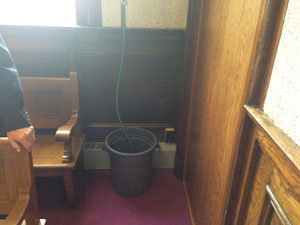During a recent tour of northern Ontario, County & District Law Presidents’ Association chairwoman Janet Whitehead found a courthouse in Fort Frances, Ont., in poor repair where judges were hearing land claim cases in a room outfitted with tarps and hoses carrying water from a leaky roof.

It’s no surprise, then, that when it comes to access to justice, those working in northern Ontario say they feel like they’ve been left out in the cold.
“So much of access to justice is reliant upon the gatekeeper of the justice system, which is the presiding judge,” says Barbara Morgan, one of 11 lawyers working in the Rainy River, Ont., district and president of the District of Rainy River Law Association.
“When you don’t have a judge here, it really becomes a hit-and-miss approach to justice.”
Some of the issues surrounding native justice arose in former Supreme Court of Canada justice Frank Iacobucci’s report on jury representation in February. While the intention was to address the issue of native representation on juries, Iacobucci noted there were a host of other pressing matters.
Despite the broader concerns about the justice system in northwestern Ontario, Morgan says the push to have a resident judge is something the court can easily address and rectify.
Northwestern Ontario includes three judicial districts: Kenora, Rainy River, and Thunder Bay. Each has its own complement of Ontario Court of Justice judges (four, one, and six respectively). But when the judge in Rainy River moved away last June, the court transferred the position to Kenora. As a result a visiting judge comes to a satellite court in the community every eight to 12 weeks and inevitably cases languish on the docket unaddressed with no disposition other than another adjournment. The remainder of the cases go ahead in Kenora, a situation that often forces people in Fort Frances and Atikokan, areas once served in Rainy River, to travel there.
For Morgan, the situation has left a “tremendous gap” in service.
So when Whitehead accepted an invitation to address the recent annual general meeting of the District of Kenora Law Association as chairwoman of CDLPA, she thought it was a good opportunity to check out some of the concerns raised by the membership in the north. As it turned out, her trip fell on the heels of the release of Iacobucci’s report.
Besides Whitehead’s concerns about the physical condition of the courthouse she visited, the delivery of justice is also reliant upon videoconferencing, something that’s not a perfect technology and that many First Nations members aren’t comfortable with. She also heard stories about limited availability of judges at satellite courts.
“It really wasn’t a question of whether there was access to justice but whether there was access to appropriate justice,” says Whitehead, who feels there are serious issues surrounding the quality of justice available in northern Ontario. “Is this really what those residents should expect?”
Whitehead has returned to her practice in southwestern Ontario but says the issues of the north remain a concern. She hopes to consult with the provincial attorney general’s office to encourage a review of the decision to leave Rainy River without a resident judge and hopes to see an alternative solution in the interim. There’s a concern, she adds, that the court could impose a similar decision without discussion or input in other rural communities in Ontario.
What struck Whitehead during her trip was one of Iacobucci’s recommendations that the attorney general study the adequacy of existing legal representation as well as the location and schedule of court sittings.
Describing the justice system for First Nations people, particularly in the north, as being in crisis, Iacobucci called for the reintroduction of restorative justice programs that “would have multiple benefits at the community level. Such benefits include the delivery of justice in a culturally relevant manner, greater understanding of justice at the community level . . . and an opportunity to educate people about the justice system and their responsibility to become engaged on the juries when called upon to do so.”
In his statement responding to the report, Attorney General John Gerretsen mostly addressed the issue of representation of First Nations people on juries. But he added that a provincial advisory group would advise the ministry on matters relating to First Nations and the justice system.
From her perspective, Morgan sees a great deal of potential for improvement in the sometimes-forgotten corner of the province. She points to Iacobucci’s observation on the importance of the community’s role in justice.
Both Morgan and Whitehead would like to see a summit of some sort that would include various stakeholders in a bid to improve the system and reduce delays. But the work won’t be complete until those involved have identified the problems, they say.
For more, see
"Travelling judge not good enough, Rainy River lawyers say."

 It’s no surprise, then, that when it comes to access to justice, those working in northern Ontario say they feel like they’ve been left out in the cold.
It’s no surprise, then, that when it comes to access to justice, those working in northern Ontario say they feel like they’ve been left out in the cold.